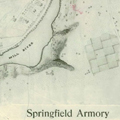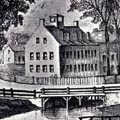|
The principal source of machine power for much of Springfield
Armory's history, especially in its early years before the installation
of steam and electrical power, was water power from a single small
tributary of the Connecticut River called the Mill River. This
minor tributary river flowed from the east into the Connecticut
River on the south side of Springfield and became the site of what
came to be known as the Watershops. The large and powerful Connecticut
River was too unpredictable and irregular to be useful.
 The Watershops were located a mile south of the principal musket
assembly site, the Hill Shops. Better and more powerful rivers
were located three miles to the north of the Hill Shops [the Chicopee
River] and on the west bank of the Connecticut River [the Agawam
River], but they were too far away to be of practical use to the
Armory. The Watershops were located a mile south of the principal musket
assembly site, the Hill Shops. Better and more powerful rivers
were located three miles to the north of the Hill Shops [the Chicopee
River] and on the west bank of the Connecticut River [the Agawam
River], but they were too far away to be of practical use to the
Armory.
General George Washington and Colonel Henry Knox noted to the
Continental Congress that the location of what became known as
the Hill Shops close to the tributary rivers near Springfield was
a major point in favor of locating the Continental Army's Arsenal
there in 1777. Not until the expansion of the same site as the
first national armory in 1795, however, did the U.S. government
tap the Mill River to provide power. The destruction by fire in
1805 of the principal water-powered forges and grinding shops,
known as the ‘ Lower Watershops ,' led to the construction
of a larger and better facility. Explosion and destruction of an
older Revolutionary War-era gunpowder mill four y ears later allowed
the Armory to enlarge and raise the height of the dam and to build
the ‘Upper Watershops' further upstream Finally, in 1811
and just before the outbreak of the War of 1812. A new and direct
road [today's Walnut Street ] was built connecting the Upper Watershops
to the Hill Shops a mile to the north. ears later allowed
the Armory to enlarge and raise the height of the dam and to build
the ‘Upper Watershops' further upstream Finally, in 1811
and just before the outbreak of the War of 1812. A new and direct
road [today's Walnut Street ] was built connecting the Upper Watershops
to the Hill Shops a mile to the north.
In 1817,
land was purchased between the Upper and the Lower Watershops to
both raise the height of the dam to the Lower Watershops and for
the creation of a smaller ‘Middle Watershops.' After a disastrous
fire two years later, the Middle Watershops were rebuilt and expanded.
A major fire in mid-1825 at the Lower Watershops destroyed most
of the new powered stocking machinery requiring rebuilding in stone
and brick. This replaced the older oil-soaked wooden structure.
 Springfield Armory's Superintendent, Col. Roswell Lee, proposed
to the Ordnance Department in 1824 that serious consideration be
given, for the sake of future production efficiency, to three proposals:
(I) that the entire armory be sold and a new site be established
at the powerful Chicopee River [the same site where Ames Sword
Company established themselves a half-dozen years later]; (II)
that the Hill Shops be closed and rebuilt around the Watershops;
and (III) that the existing Armory be extensively rebuilt and expanded.The
third option was acted upon and elements of the second plan were
realized when the Upper Watershops were eventually expanded and
the Lower and Middle Watershops closed in 1857. Springfield Armory's Superintendent, Col. Roswell Lee, proposed
to the Ordnance Department in 1824 that serious consideration be
given, for the sake of future production efficiency, to three proposals:
(I) that the entire armory be sold and a new site be established
at the powerful Chicopee River [the same site where Ames Sword
Company established themselves a half-dozen years later]; (II)
that the Hill Shops be closed and rebuilt around the Watershops;
and (III) that the existing Armory be extensively rebuilt and expanded.The
third option was acted upon and elements of the second plan were
realized when the Upper Watershops were eventually expanded and
the Lower and Middle Watershops closed in 1857.
Not until 1848 were the roads and bridges associated with the
Watershops improved and efforts begun to expand the power pond
above the Upper Watershops. By 1857, on the eve of the Civil War,
the Lower Watershops had been sold, the Middle and Upper Watershops
combined into a single large Watershops complex, and the dam at
that site rebuilt and greatly enlarged rising ten feet higher thereby
flooding eighty-one acres and creating what has come to be known
as Watershops Pond.
Successful Achievement of Mechanized Interchangeable Production
|